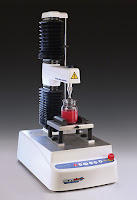Texture measurement is a crucial process in product development and quality control, especially in industries like food, pharmaceuticals, and materials science. However, achieving accurate and reliable results can be challenging due to various pitfalls.
1. Inconsistent sample preparation
Problem: Variability in sample size, shape, and condition can lead to inconsistent results.
Solution:
- Standardise preparation: Use templates, moulds, or cutting guides to ensure all samples are uniform in size and shape.
- Control environment: Maintain consistent environmental conditions (temperature, humidity) during preparation and testing.
Example: For a compression test on gel samples, use a mould to prepare samples with identical dimensions and store them in a controlled environment before testing.
2. Improper calibration
Problem: An improperly calibrated Texture Analyser can produce inaccurate measurements.
Solution:
- Regular calibration checking: Checking the force calibration of the Texture Analyser regularly using standard weights and known distances.
- Follow calibration guidelines: Adhere to the Load Cell installation and calibration procedures.
Example: Perform a weekly calibration check using certified calibration weights to ensure the Load Cell is measuring force accurately.
3. Inadequate environmental control
Problem: Fluctuations in temperature and humidity can affect the material properties and measurement accuracy.
Solution:
- Consistent conditions: Conduct tests in a climate-controlled environment to maintain consistent temperature and humidity levels.
- Use temperature/environment chambers: Store and test samples in environmental chambers when necessary.
Example: Use an environmental chamber set to 25°C and 50% relative humidity to store and test sensitive food samples like chocolate.
4. Incorrect probe or fixture selection
Problem: Using the wrong probe or fixture can lead to misleading results or damage the sample.
Solution:
- Choose appropriately: Select probes and fixtures designed for the specific test and material being analysed. If necessary, call upon our Test advice service to guide you.
- Refer to help files: Consult the Education Zone/Help files for recommendations on probe and fixture selection.
Example: For a tensile test on a plastic film, use Self-Tightening Tensile Grips designed to hold thin, flexible materials securely without slipping.
5. Inconsistent test settings
Problem: Variations in test speed, force limits, or other parameters can lead to inconsistent results.
Solution:
- Standardise test settings: Use the same test settings (speed, force limits, distance) for all samples in a batch.
- Document settings: Record test settings and ensure they are consistently applied across all tests and share with colleagues performing the same tests.
Example: For a compression test on bread samples, set the test speed to 2 mm/s and ensure this speed is used for all tests.
6. Overloading or underloading the Load Cell
Problem: Applying forces outside the Load Cell’s capacity range can damage the equipment or produce inaccurate results.
Solution:
- Check capacity: Ensure the Load Cell’s capacity range matches the expected forces for the test.
- Use appropriate Load Cells: Switch to a Load Cell with a suitable capacity range if necessary.
Example: For testing the hardness of a dense material like rubber, use a Load Cell with a higher capacity range to prevent overload.
7. Poor data interpretation
Problem: Misinterpreting the data can lead to incorrect conclusions about the material properties.
Solution:
- Training: Ensure operators are trained in data interpretation and understand the significance of different curve features.
- Software tools: Use the correct data analysis software tools for detailed analysis and visualisation of the data.
Example: For a texture profile analysis (TPA), ensure the operator understands how to interpret parameters like hardness, cohesiveness, and springiness from the force-distance curve.
Practical tips for reliable texture measurement
1. Consistent sample handling: Handle samples gently and consistently to avoid altering their properties.
2. Multiple replicates: Test multiple samples from the same batch to account for natural variability.
3. Detailed documentation: Keep detailed records of sample preparation, test parameters, and environmental conditions.
4. Regular maintenance: Perform regular maintenance on the Texture Analyser to ensure it operates correctly.
We have also prepared a Texture Analysis Professional checklist for you to consider:
Or if you have lost it, request a 167 page (pdf) in-depth manual to be sent to you.
There is a Texture Analysis test for virtually any physical property. Contact Stable Micro Systems today to learn more about our full range of solutions.
For more information on how to measure texture, please visit the Texture Analysis Properties section on our website.
The TA.XTplusC Texture Analyser is part of a family of texture analysis instruments and equipment from Stable Micro Systems. An extensive portfolio of specialist attachments is available to measure and analyse the textural properties of a huge range of food products. Our technical experts can also custom design instrument fixtures according to individual specifications.
No-one understands texture analysis like we do!
Get in touch to discuss your specific test requirements
 |  |  |







No comments:
Post a Comment